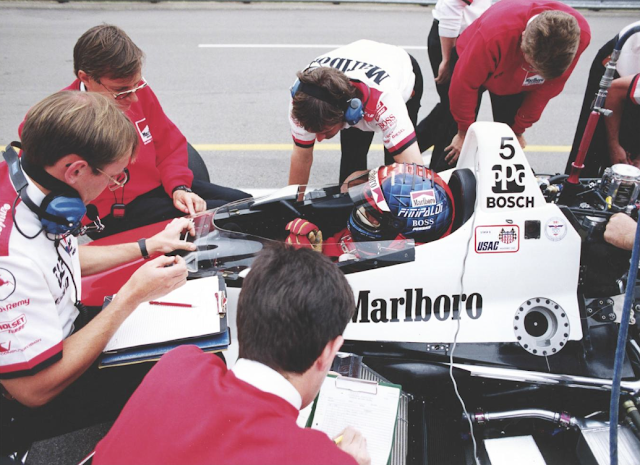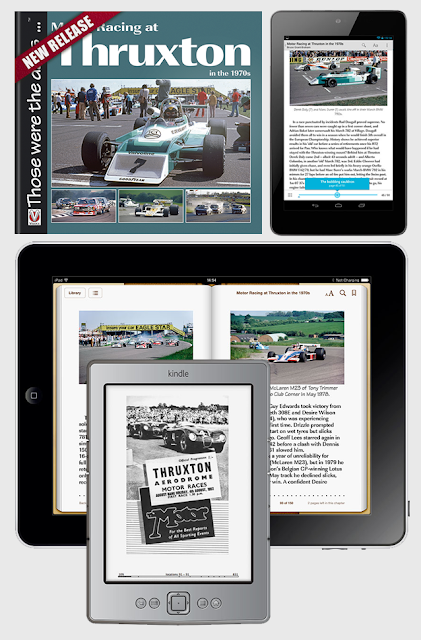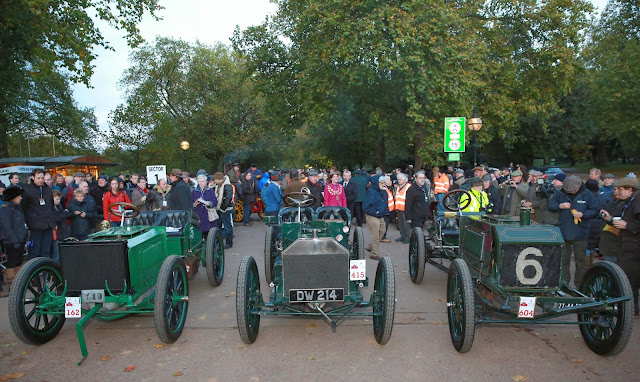Of British descent, Norm Mort was raised in Toronto where vehicles from every corner of the world were sold. He began taking pictures of old cars and trucks parked at the side of the road before he was ten. At 12 years of age, Norm was the youngest member on the executive of the Antique and Classic Car Club of Canada, Toronto Chapter. In the 1960s he began accumulating photos and information on motoring. Over the years his personal vehicle collection has included everything from a 1949 Allard to a 1922 Vauxhall. A writer for magazines and newspapers in the field of transport for nearly 25 years, and a member of the Canadian Society of Automotive Historians, Norm is the author of
9 Veloce books.
The Norm Mort Veloce collection, so far ...
For some reason, cars in general – and old cars in particular – have always interested me, ever since I was a toddler zoom-zooming my Matchbox series cars across vast hardwood floors and through chair and table legs. History has also always fascinated me, and early interests – apart from toy cars and trucks – were the American Civil War and WWI airplanes. Fortunately I had great parents who encouraged these interests.
From the time I was about seven and armed with a simple Brownie camera, my Dad would stop the car whenever I spotted some old car at a gas station or along the road. I still have all my black and white photos in an album, and in fact, have used some of them in newspaper and magazine columns, and even in a few of my books published by Veloce.
Ford Model A in 1964.
Using money saved from part-time after school jobs, I first bought a 1962 Triumph TR3A. It was in great shape for a seven year old car, and cost me $425.00 after I talked the original owner down $25.00. I liked the Triumph as the styling was far more “vintage” than the newest TR250 or an MGB.
After graduating from high school I was accepted by the University of Toronto but, a week before I went to orientation, I was in a serious accident. On a twisty country road I rounded a corner only to find a rather large rock had fallen. I swerved to miss it, but it caught the front wheel, and braking hard the Triumph spun around. I continued down the road backwards. At the bottom of the hill the TR slid-off into the ditch and flipped over.
I guess I was lucky the Triumph had cut-down doors, as I went through the driver’s side-curtain and was pinned underneath. I was even luckier: my brother-in-law was right behind me and turned off the ignition. He pulled me out and went to call an ambulance. Perhaps it was the fact I was just about to start university, but I recall my first thought was whether I had brain damage. No, I was no dumber than I was before, although at time I didn’t realize I had a jaw broken in two places and a broken shoulder, as well as some minor lacerations!
Despite the crash I eventually got the car running again, fitted a new windscreen and steering wheel, and sold it for $200 toward a restored 1936 Chrysler Airstream four-door sedan. That Chrysler became my daily driver over the next two years of University, where I majored in history and anthropology.
I enjoyed driving the old Chrysler, it being quite different to the 1960s sedans and station wagons most students drove. I was also given great latitude in campus parking. If the lot was full, I parked in the professor parking. The security guards would often remark they’d seen it in the restricted parking area, but they liked the car and found my comment “Hmmm, are you sure it wasn’t somebody else’s ’36 Chrysler?” quite amusing.
When I started dating my wife-to-be we drove the Chrysler everywhere. One night on a busy downtown street the clutch sank to the floor. I quickly discovered if I turned off the car, slipped it into first gear, then started it again, it drove okay. I was able to shift the non-synchromesh transmission by ear, get home to my parent’s house, and borrow dad’s car to carry on for the evening.
I soon spotted a 1967 Triumph Spitfire for sale, and decided to upgrade to attend teacher’s college in the fall. It had three wire wheels, and a steel wheel on the rear left because the splines were shot. I used a chisel on it to deepen the splines, which worked for a while, but I was soon rolling along on three wires again. Then a U-joint went. A fellow at work wanted the car for him and his dad to repair; thus, it went in favour of another friend’s 1970 Fiat 850 Spider.
The rear engine Spider was very sophisticated compared to the Spit, and pretty reliable except for the constantly frozen door locks – we had to use my by-then fiancé Sandy’s lighter to heat the key to turn them. Wining and dining was a favourite pastime, so there was never money for such mundane things as tires, and during a rain storm driving on a sweeping uphill curve I lost it. The diminutive Fiat spun and flipped over.
Anyone who has been in an accident knows that feeling of time standing still. My first thought as I rolled into the air was, “Oh no, not again!”. I also thought – “Fall towards the passenger seat.” Well, the gods were kind, and the large electric fan I was transporting on that seat somehow went into the footwell. Also, the highback bucket seats prevented the full pancake effect.
Being experienced in this situation, I turned-off the ignition and carefully peeked out the passenger side. I knew I was okay, but with all the heavy traffic I was frightened somebody would hit the car from behind and smear me across the highway. As I looked out a nice young lady asked if I was alright. I said I thought so, and pushed myself out of the car. (Who needs a rollbar when you have highback bucket seats?!) The young lady said, “Oh thank goodness. I just graduated as a nurse so I felt I had to stop, but was afraid there’d be a lot of blood!”
I called Sandy and told her I was fine. She got a ride down to the hospital, and just as she walked into the room a doctor was looking at me behind the curtain. He asked me to remove my shirt. Unfortunately, when they set my shoulder after the previous accident it was a bit of a botch-up, even though they did it twice. The end of a bone bulged out just over an inch where they had wired it – rather unusual looking, to say the least. When the young doctor saw this bone he yelled out “Oh my gosh!” and I had to assure him I was fine. My dad had to come and pick us up, and over dinner my parents said they hoped I was finished with sports cars and convertibles. That would not be the case.
My next car was a safe, but sporting, 1966 Rover 2000SC, but despite only having 29,000 miles on the odometer it seemed to break down every other week. Sandy and I married in the summer, but not before both the rebuilt Fiat 850 and Rover were traded in for a ‘cute’ but hardly sporting, Toyota Corolla Sprinter.
I had to travel an hour each way to my teaching job, and after a year the pristine looking Toyota sent a piston through the side of its block. We had two cats and a dog by that time, so air-conditioning in our next car was a must. Thus, it was an AMC Gremlin X with the very cool ‘Levi’ interior that became our daily transport. Another old car was soon added in the form of a Humber Super Snipe, but a short term parking problem saw it go. Within six months I had bought Sandy a decade old, but fully rebuilt 1968 Mustang convertible. Alas, that was stolen from the underground parking at our condo, and immediately replaced by a huge Canadian-built, 390ci V8 Mercury Meteor Montcalm convertible.
A move north of Toronto into a house for our imminently expanding family resulted in both remaining cars being replaced by a 1980 Volkswagen Rabbit convertible. It proved not to be the most reliable, and its folded roof was difficult for Sandy to see over, so when a local Chevrolet/Oldsmobile dealer offered us a family-sized Oldsmobile Omega sedan and an MGA roadster, it was a good time to sell.
The MGA was the reason I started writing about cars. I was a member of the MG Owner’s Club, and became a regular contributor to its publication for a few years. Our son, Andrew, would travel to school with me in the MGA. His seatbelt on and the tonneau cover closed and keeping him safe and warm, there were many laughs when the passenger door would slowly open seemingly by itself and he’d pop out. Today, our very young grandchildren aren’t legally allowed to even ride in this kind of car, but things were very different in the 1980s.
Norm with his son, Andrew.
Many cars have come and gone since then, as have thousands upon thousands of newspaper articles and magazine features. Over the past five years or so, I’ve written eleven books along with Andrew, who contributed his photographic talents. Nine of these were published by Veloce.
Our first book for Rod Grainger and Veloce was
Micro Trucks, which was a wonderful experience and so much fun to write. Mario Palma, a microcar and truck collector extraordinaire, provided us with all the trucks, as well as the ideal location to shoot them in a wide range of interesting settings. It was at this time I discovered the Autobianchi van was the perfect 500 variation on the theme for me – as well as for my constant companion Austin, our Golden Retriever.
Since then I have written books on Anglo-American cars, American ‘independent’ automakers, American woodies and station wagons, American trucks, and a buyer’s guide on Triumph Stags. With Andrew, I also had the pleasure of writing
Dogs on Wheels – published by Veloce’s pet-focussed imprint, Hubble and Hattie – which aimed to provide a greater understanding of the importance of travelling safely with your canine companion.
Norm's dog Austin.
Norm in his Autobianchi.
Currently, a 1989 Volvo 960 and a 2005 Chrysler Crossfire convertible are our daily drivers, but we also have a 1957 BMW Isetta, a 1961 Alfa Romeo Giulietta Spider, a 1962 Triumph TR4, a 1962 Sunbeam Harrington Le Mans, a 1966 Autobianchi 500 Furgonette (like the one featured in Micro Trucks), a 1967 Reliant Regal 3/70, and a 1985 AMC/Renault Alliance Convertible crowded into our garage. Some await restoration, while others are drivers being enjoyed whenever possible.
For nearly a decade I was a member of the Studebaker Driver’s Club, but have never owned one, so a Lark station wagon would be an ideal next car, or an AMC Rambler. Even a Pacer station wagon would be nice – particularly for our two lovely Golden Retrievers and two happy grandchildren.
As for future titles, a children’s book is in the works, and I’d love one day to do something on Alfa Romeo. Watch this space ...
Click here to view all Veloce books by Norm Mort.



















































